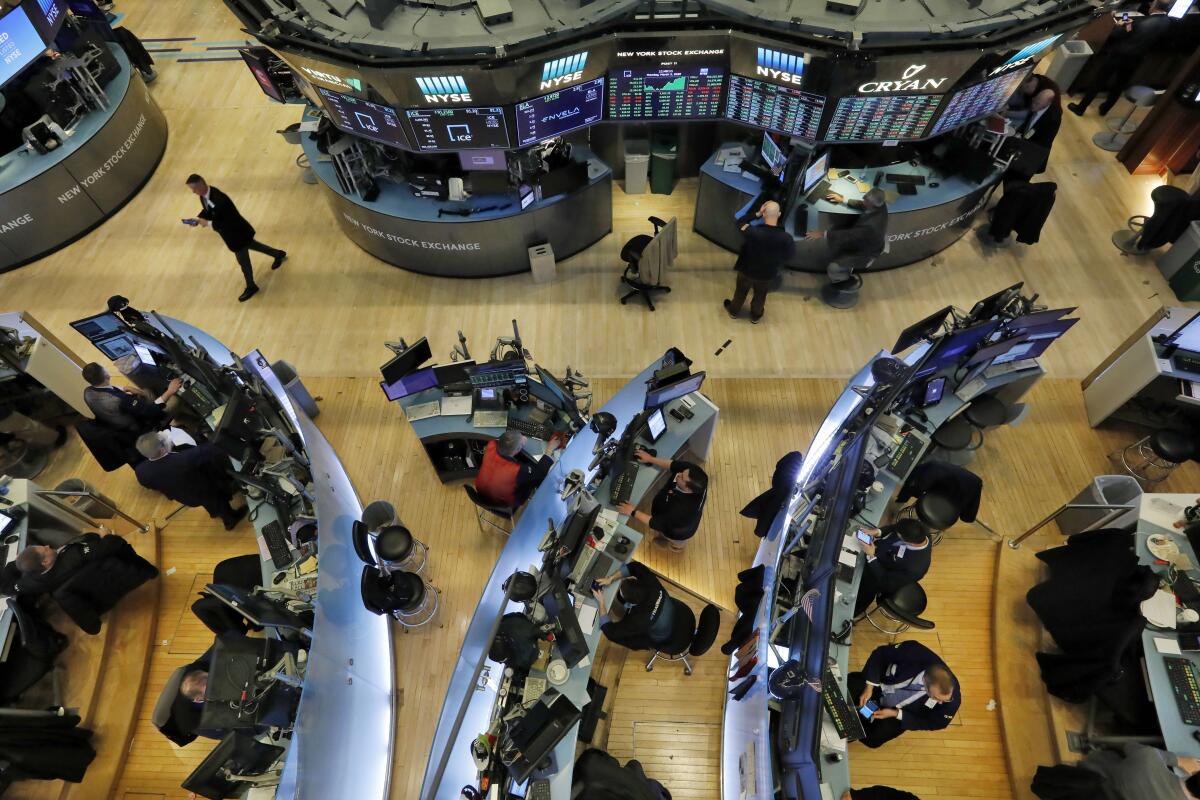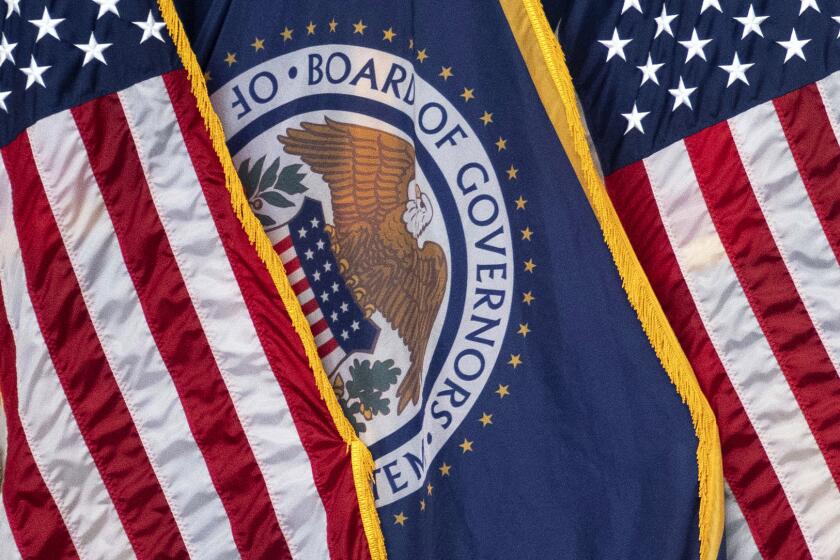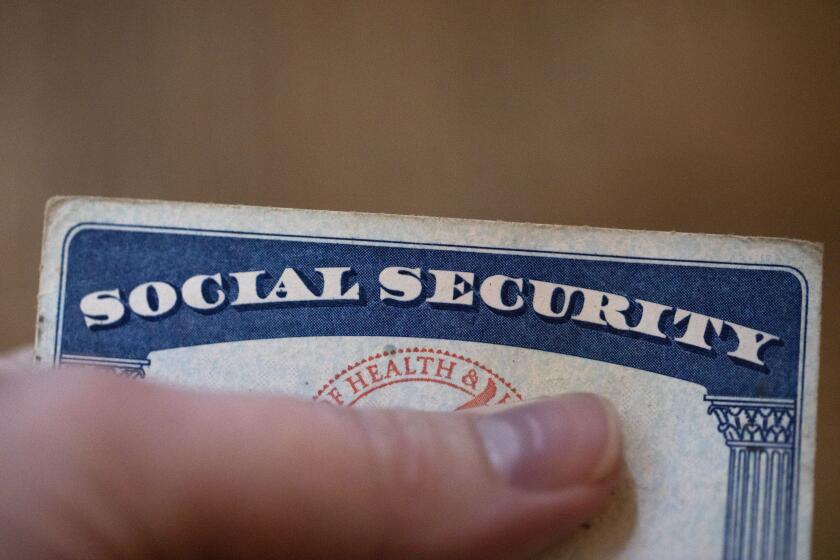Wall Street struggles as war worries collide with hope for stronger profits

- Share via
U.S. stocks mostly fell Friday after fears about war in the Middle East collided in financial markets with hopes for stronger profits at big U.S. companies.
Oil prices leaped and Treasury yields fell after Israel’s military ordered the evacuation of northern Gaza ahead of a possible ground invasion, according to the United Nations, which warned of potentially “devastating humanitarian consequences.” But several U.S. banking giants at the same time said their profits during the summer were better than feared, which offered hope on Wall Street for an earnings reporting season that may deliver the first growth for big companies in a year.
All the push and pull left the Standard & Poor’s 500 index down 21.83 points, or 0.5%, at 4,327.78. The Dow Jones industrial average edged up 39.15 points, or 0.1%, to 33,670.29, and the Nasdaq composite dropped 166.98 points, or 1.2%, to 13,407.23.
Some of the strongest action was in the oil market, where a barrel of benchmark U.S. crude jumped $4.78 to $87.69. Brent crude, the international standard, climbed $4.89 to $90.89 per barrel.
Israel continues strikes after warning over a million northern Gazans to head to the southern strip — a displacement the U.N. says would be calamitous. Many stay behind.
Although the Gaza region is not a major producer of oil, the fear is that the violence could spill into the politics around the crude market and eventually lead to disruptions in the flow of petroleum.
Worries about the war also sent Treasury yields falling, which often happens when investors look for safer investments during times of stress. The yield on the 10-year Treasury fell to 4.63% from 4.70% late Thursday.
Yields also eased after another official at the Federal Reserve said the central bank may be done raising its main interest rate following a blistering campaign that began early last year.
Patrick Harker, president of the Philadelphia Fed, said again Friday that he believes “we are at the point where we can hold rates where they are” as long as economic and financial conditions continue on their current course.
The Fed has pulled its overnight interest rate to the highest level since 2001, up from virtually zero at the start of last year, in hopes of starving painful inflation of its fuel. High rates and longer-term bond yields knock down prices for all kinds of investments, while also slowing the overall economy.
Harker said the Fed can afford to stop raising rates and see what happens, particularly with so many economic uncertainties. Besides the war in Gaza and oil prices, there are also worries about the effects of workers’ strikes across the country and Capitol Hill dysfunction that could result in another U.S. government shutdown.
“By doing nothing, we are still doing something,” Harker said about holding rates steady at their high levels. “And, actually, we are doing quite a lot.”
The two-year Treasury yield, which tends to move closely with expectations for Fed action, fell to 5.03% from 5.07% late Thursday.
The Federal Reserve left its key interest rate unchanged for the second time in its last three meetings, a sign that it’s moderating its fight against inflation.
A report Friday suggested sentiment among U.S. consumers, whose spending has been one of the main drivers keeping the economy out of a recession, may be waning. A preliminary reading from the University of Michigan said consumer sentiment weakened by more than economists expected, primarily because of increased worries about inflation.
U.S. consumers are girding for inflation of 3.8% for the year ahead, up from 3.2% last month. It’s the highest such reading since May.
The Fed pays attention to the consumer sentiment report, particularly on expectations for inflation. The uptick there could keep alive the possibility of another rate increase by the Fed in December or January, said Bill Adams, chief economist for Comerica Bank.
Helping to support Wall Street were JPMorgan Chase and Wells Fargo, which reported stronger profit for the summer quarter than analysts expected.
JPMorgan Chase rose 1.5% after its profit for the third quarter rose 35% from a year earlier. It benefited from a rise in interest rates, but Chief Executive Jamie Dimon also warned that “this may be the most dangerous time the world has seen in decades.”
Wells Fargo rose 3.1% after it likewise topped analysts’ expectations for profit during the summer quarter. Bank customers continue to borrow, even at higher interest rates, as consumers put more and more expenses on their credit cards.
UnitedHealth Group also beat Wall Street’s profit expectations, and its stock climbed 2.6%.
Dollar General jumped to one of the biggest gains in the S&P 500, up 9.2% after it said Todd Vasos will be returning as CEO.
The acting Social Security commissioner says a 3.2% increase in benefits next year ‘will help millions of people keep up with expenses.’
On the losing end of Wall Street were travel-related companies. Norwegian Cruise Line fell 4.1%, and Delta Air Lines sank 3%.
Investment giant BlackRock fell 1.3%, even though it reported stronger profit for the latest quarter than analysts expected.
BlackRock said all the uncertainty around financial markets and the outlook for interest rates helped drive clients to pull some money out of long-term investments as they hide out in cash, which is finally paying higher yields.
In stock markets abroad, indexes were lower across Europe after falling more sharply in Asia.
AP writer Zimo Zhong contributed to this report.
More to Read
Inside the business of entertainment
The Wide Shot brings you news, analysis and insights on everything from streaming wars to production — and what it all means for the future.
You may occasionally receive promotional content from the Los Angeles Times.













